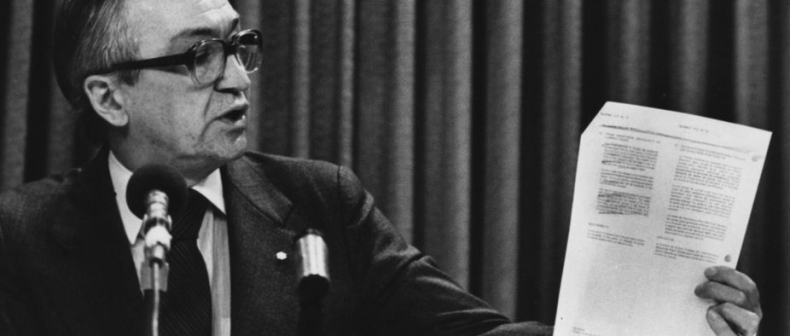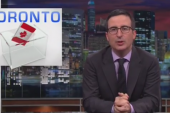
Who wants to grow up to be a civil servant? Anyone? Civil servants are whipping boys for people jealous of their pensions, and convenient fall guys if they happen to disagree publicly with their bosses. The kind of large-scale government initiatives they spent most of the last half of the 20th century creating are now virtually verboten, rarely celebrated and frequently under attack.
Why mourn the death of any particular civil servant? Pierre Juneau, who passed away on Feb. 21, was so much more than that. As much as any politician, businessman, writer or philosopher, he transformed Canadian culture. And yet if he’s known at all, it’s as a footnote to the history of the Juno Awards, which were named after him.
Pierre Juneau was the Zelig of Canadian cultural institutions, during a time when Canada was trying to figure out exactly what it was, who we were, and what we could be. He worked at the National Film Board from 1949 to 1966, eventually becoming head of French-language production. He worked with a young Pierre Elliot Trudeau on the Quebecois magazine Cité Libre in the ’50s, which was instrumental in instigating the Quiet Revolution in that province. He co-founded the Montreal International Film Festival. Trudeau appointed him the first head of the Canadian Radio-Television Telecommunications Commission (CRTC) in 1968, and Juneau briefly served as Minister of Communication in Trudeau’s cabinet (he was appointed without a seat in the House of Commons, and lost in a subsequent byelection). He became head of the CBC in 1982, and launched Canada’s first all-news network, CBC Newsworld, in 1987.
That’s quite a career. But really, it’s nothing next to the fact that he practically created the Canadian music industry single-handedly in 1971. That was when Juneau, as head of the CRTC, introduced regulations that insisted Canadian radio stations devote 30 percent of their playlist to Canadian content. (It was upped to 35 percent in 1999.)
Before that, musicians had to leave the country if they wanted a career. That’s what all the Canadian success stories had previously done (with the exception of Gordon Lightfoot, who stayed here, but recorded in the U.S.). In the late ’50s and early ’60s, Canadians had to leave if they even wanted to make a record: there were literally no recording studios here outside of radio stations and jingle agencies. When popular local live acts starting making records in the ’60s, Canadian radio rarely, if ever, got behind it. The one man who went to bat for Canadian talent, Walt Grealis, was often laughed out of rooms for suggesting that a music industry could be built here. When the CRTC was formed, one year after the patriotic outpouring of Expo 67, talk of CanCon regulations started making the rounds. Such transformative, Sisyphean notions were in vogue at the time: think of bilingualism and the metric system.
By 1968, Canadian music was in full swing; many Canadian artists had been taken under the wing of Bob Dylan’s powerhouse manager, Albert Grossman (Ian and Sylvia, Gordon Lightfoot, The Band, Leonard Cohen). Joni Mitchell and Neil Young were putting out their debut albums. The Guess Who was a couple of years away from being a million-selling singles act in North America. The Yorkville music scene was burgeoning and had moved well beyond music for folkie coffeehouses.
In June 1969, as the threat of CanCon regulations loomed, radio stations pre-emptively formed the Maple Leaf System (MLS), intending to develop and promote Canadian talent. The organization went through three chairmen in less than a year, however, and floundered quickly. Radio stations claimed they were already extremely supportive of Canadian music. A study by Grealis begged to differ: he claimed that in the nine major Canadian radio markets, the stations were playing less than one half of one per cent Canadian content.
The radio stations’ protests were moot, anyway: in 1970, Canadians had 16 singles and six albums on the Billboard charts. Granted, that suggested CanCon was maybe unnecessary, that success was achieved without it. But the galvanizing effect CanCon had was immediate: professional studios started to be built in Canada, major labels signed Canadian acts to at least domestic deals, if not international ones, and an abundance of Canadian acts were suddenly heard on the radio.
There were bumps along the road, to be sure. Canadian radio stations were convinced that the gun pointed at their head forced them to play cheap, amateurish recordings that would cause listeners–and thereby advertisers–to flee in droves, putting them out of business. The only real instance where that might have been true would be in border towns like Windsor, where the groundbreaking station CKLW (aka. The Big 8) took a major hit because CanCon rules caused them to lose their audience in Detroit, where they were a market leader. (Check out the excellent documentary Radio Revolution for more on that story.)
No doubt some stinkers slipped onto the airwaves that didn’t cut the mustard compared with the American and British hit parades. Some of it probably deserved to be thrown in “the Beaver Bin,” programmers’ term for the receptacle where they would usually fling Canadian discs. Surely it’s a subjective argument, however: you could take any American or British chart from any week of any year and unearth piles of steaming shit. As music writer Ritchie Yorke told the original CRTC hearings looking into CanCon regulations, the #1 radio hit during that particular week in 1968 was the bubblegum confection “Yummy Yummy Yummy (I’ve Got Love in My Tummy).” And yet Top 40 radio was somehow worried about Canadian music not meeting some arbitrary artistic standard?
It’s easy now to look back and sympathize with the radio stations’ resistance. Needless to say, no private industry has ever embraced government regulation, unless it kept foreign competition out. This pitted the gatekeepers against the content providers, a division that’s practically non-existent now in the music industry. Radio’s power back then cannot be underestimated. Forty years ago, it was the one and only route to success: without radio, you simply did not have a hit record, and you therefore probably did not have a career outside playing your local bars. If Canadian radio did not play Canadian records, there would be no Canadian music–just people who left the country to sing wistful songs about childhoods spent in towns in northern Ontario, wishing they had a river on which they could skate home.
CanCon was necessary because radio programmers were lazy–as they often are. Why develop your own playlist when you could just pick up Billboard and play the records listed there? Sadly, that laziness extended to CanCon as well, which is why you will still hear the Guess Who twice an hour on oldies stations and Nickelback twice an hour on modern rock stations. When I first started listening to Top 40 radio in the early ’80s, Toronto’s 1050 CHUM mysteriously seemed to play a lot of Canadian records after 10 pm; I wasn’t a particularly conspiratorial 12-year-old, but even I could figure out that their “beaver bin” was only dusted off after prime-time hours were past.
The Bryan Adams and Bruce Allens of the world argue that the best Canadian music will succeed without CanCon’s help, the proverbial cream rising to the proverbial top. Why, then, should radio stations invest in a proverbial cow? Yet every country in the world produces art that, for whatever intangible reason, is beloved at home and doesn’t transcend national borders. To the chagrin of Tragically Hip fans, Canada is no different. CanCon recognized that the depth of talent in this country was much larger than five or six successful acts who enjoyed the combination of a vigorous work ethic, the right connections, and sheer luck. If you didn’t make it in New York, it didn’t mean your career was over.
These days, cultural nationalists are happy to say that protectionism and government programs led to so-called watershed moments, like Arcade Fire winning the Album of the Year Grammy in 2011. More often than not, however, we’re still late to our own party. No one in Canada–other than the usual entry-level champions–gave a shit about Arcade Fire before their 2004 debut album became an international sensation through word of mouth. Justin Bieber? A YouTube phenomenon that could have happened anywhere. Drake? Posted mixtapes online and became famous via more-famous friends. In the Internet age, some artists are destined for a meteoric rise, and the Canadian industry doesn’t even have time to catch up.
CanCon doesn’t help people become superstars; that’s usually attainable only through divine intervention, no matter where you’re from. What CanCon does is flesh out the rest of our domestic music industry. There is strong infrastructure here providing a helping hand to hundreds if not thousands of acts in every genre, from touring grants to FACTOR recording grants (funded largely, it should be noted, by private radio) to festival programming to the tireless (and sometimes even tiresome) championing by the CBC. Culture is one of this country’s major economic engines. It all began with Vincent Massey’s artistic state-of-the-nation report in 1951; it was Pierre Juneau who kicked it into high gear.
In 2012, the idea of CanCon seems almost laughable. We certainly can’t impose CanCon on the Internet, as even the CRTC has now reluctantly admitted. Radio is dead. You can sell hundreds of thousands of records and fill major theatres without ever being played on commercial radio. You can give your music away for free, avoid all press and become one of the most talked-about sensations of the year. Today, consumers have all the control, via an endless number of platforms–and lo and behold, Canadian music is stronger than ever, domestically and internationally, in all genres.
And that, ultimately, is Pierre Juneau’s legacy.
______
Michael Barclay is the co-author of Have Not Been the Same: The CanRock Renaissance 1985-1995. Follow him on Twitter at @mmmbarclay.
For more, follow us on Twitter @TorontoStandard or subscribe to our newsletter.














